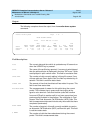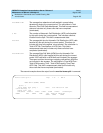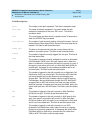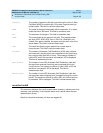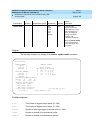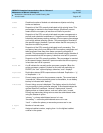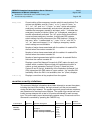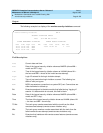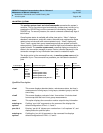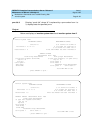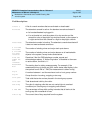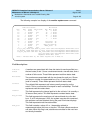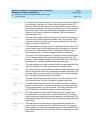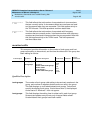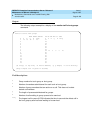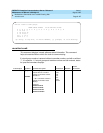
DEFINITY Enterprise Communications Server Release 6
Maintenance for R6vs/si
555-230-127
Issue 1
August 1997
Maintenance Commands and Trouble-Clearing Aids
Page 8-160monitor system
8
monitor system
The monitor system view1 and view2 commands summarize the system’s
condition. This on-line status report automatically updates every minute (or by
pressing the UPDATE key) until the command is canceled by pressing the
CANCEL key. For security reasons, the cancel command automatically logs of
technicians.
Overall system status is available with either view option. “View1” displays
attendant, maintenance, and traffic status. Attendant and maintenance status
update every minute and traffic status updates hourly. “View2” displays all
“view1” items, except hunt group measurements that are omitted from traffic
status portions. These screens contain simplified high-level information about the
system’s health. The monitor system conn command displays connection’s
status in the connection manager process. Data is collected frequently in the
connection manager for key information items used to create this report.
The single option to the command line entry, is monitor system conn and its
parameter is
pnn
. The command line parameter
pnn
indicates the desired 3
pnns.
Qualifier Description
Action/Object Qualifier Qualifier Description Permissions Defaults
Feature
Interactions
monitor
system
view 1
view 2
conn
pnn ###
pnn ###
pnn ###
see below
Examples:
monitor system view1
monitor system view2
monitor system conn
monitor system conn pnn 1 5 7
init
inads
craft
cust
nms
browse
none none
view1 This screen displays attendant status, maintenance status, last hour’s
measurement of trunk groups, hunt groups, attendant groups, and the
time of day.
view2 This screen displays a subset of view1 form entries. It includes view1
forms except the last hour’s hunt group measurements.
conn This option displays the connection monitor output for key information.
entering no
options
Omitting “pnn # # #” arguments on the command line displays the
default configuration of Pnn’s 1, 2 and 3.
pnn # # # Entering “pnn # # #” (where a pnn number from 1 to 3 replaces “#”, and
displays data for specified pnns.
entering no
options
Omitting the “pnn # # (# argument on the command line displays
default configurations of Pnn’s 1, 2 and 3.



